Raising Water Consciousness through
World’s Biggest Photo Exhibition and
Largest collection of Photo Stories on Water
Photo Stories | Drinking Water
Jal Jeevan Mission: Recommendations for Improving its Effectiveness in Jharkhand
Nandita Singh and Om Prakash Singh
24 October, 2025
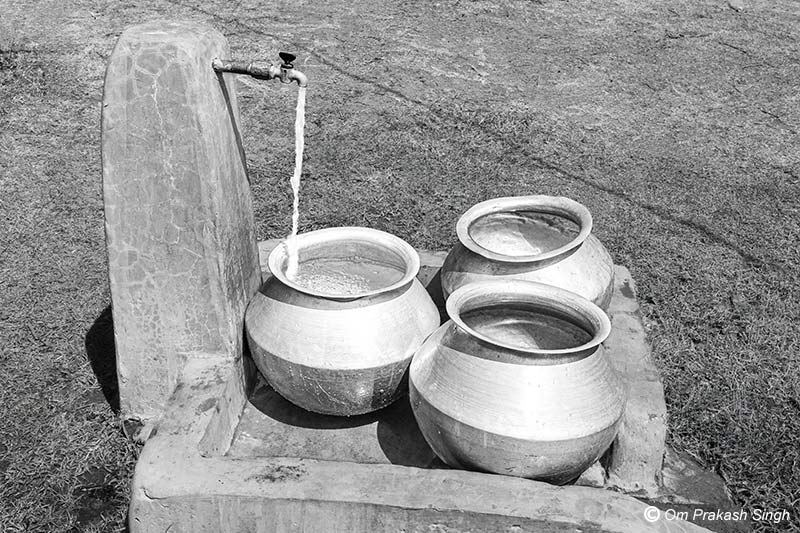
The Jal Jeevan Mission (JJM), launched in 2019, aims to ensure universal access to safe drinking water by providing Functional Household Tap Connections (FHTCs) to every rural household and public facility. A tap connection is deemed functional if it satisfies three essential criteria: adequacy (a minimum of 55 liters per person per day), regularity (daily supply or as per community norms), and potability (compliance with BIS:10500 water quality standards). In Jharkhand, FHTCs under JJM are supplied through either Single Village Schemes (SVS), which rely on groundwater sources, or Multi-Village Schemes (MVS), which utilize surface water. An earlier publication titled “Jal Jeevan Mission: Action for its Implementation in Jharkhand”, outlined the program’s rollout across the state. While JJM has significantly increased rural tap water coverage in Jharkhand, as documented in previous articles, a more pertinent concern pertains to the quality and effectiveness of the services delivered. Another article, “Jal Jeevan Mission: Some Gaps in its Implementation in Jharkhand”, evaluated the operational status of both SVS and MVS schemes and examined the factors influencing their performance. This assessment was based on a field study conducted by the authors in March 2025, encompassing 39 JJM schemes across 28 villages in four districts: Seraikela-Kharsawan, Khunti, Gumla, and Latehar. The article revealed that in several villages, including those labeled or certified as Har Ghar Jal (“water in every household”), full functionality or access to a functional tap is still a significant challenge. The study identified numerous deficiencies, both in terms of infrastructure (‘hardware’) and institutional or behavioral (‘software’) components, which hinder the effective functioning of FHTCs. A subsequent publication, “Jal Jeevan Mission: Consequences of the Gaps in its Implementation in Jharkhand”, further illustrated the adverse impacts on women and girls in communities where JJM schemes have been implemented but taps remain dry or the water supply is inadequate, irregular, or perceived as unsafe. The article also highlighted the consequences in areas where JJM implementation has been delayed or remains incomplete. Drawing upon insights from these prior publications, as well as broader observations on JJM’s implementation in Jharkhand, the present photo article proposes a set of strategic recommendations aimed at enhancing the program’s overall effectiveness. The title image features a well-designed and fully functional FHTC located in the courtyard of a rural household in Khunti district. This tap delivers potable water at adequate pressure and for the stipulated duration each day, thereby meeting the household’s diverse domestic water needs.
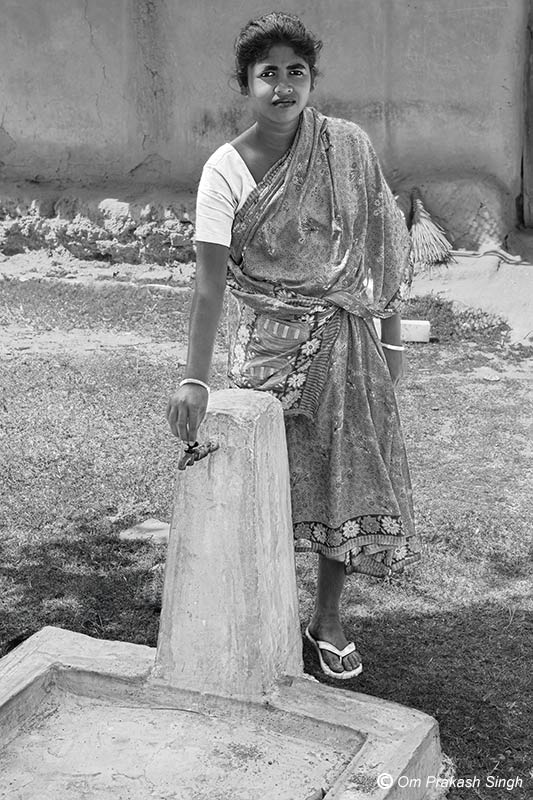
A non-functional tap in a rural household in Khunti district
As elaborated in the previous publication regarding the gaps in JJM implementation in Jharkhand, several hardware-related issues lead to schemes that function partially or become non-functional, ultimately resulting in dry taps. These primarily include broken, leaking, or missing taps; damaged or leaking pipelines; faulty designs; poor construction quality; and missing or non-operational components. The FHTC seen in the above photo has been dry from almost the very beginning, but it has failed to receive attention from the agency as well as authorities. To prevent such situations, there is a need to ensure prompt action at three levels. First, the resource mapping should be done with the engagement of villagers and the preparation of village action plan should be participative in the planning phase of the schemes. Second, rigorous monitoring of the layout and construction of new schemes to ensure functionality from the start. Third, an efficient grievance-redressal system where all complaints regarding breakdowns are recorded and addressed promptly. The use of technology for grievance redressal and involvement of third- party agencies for quality certification should be deployed. The agencies responsible for construction and maintenance of the schemes must be held accountable for their lapses.
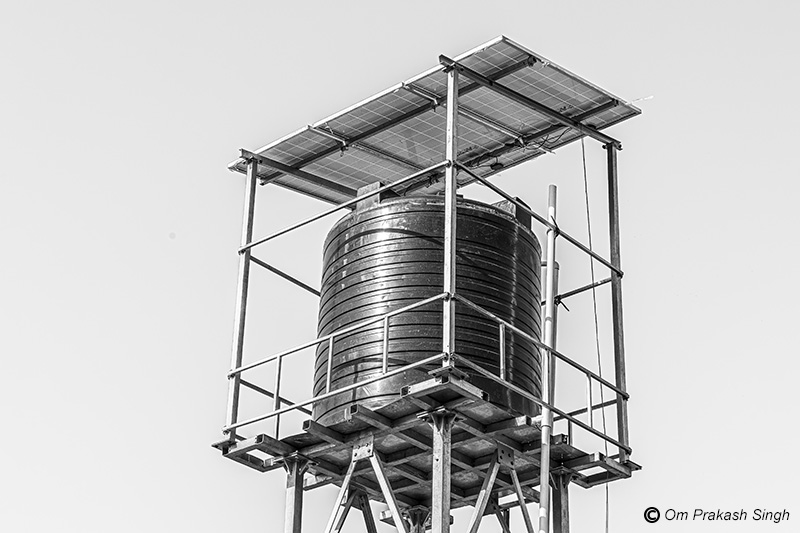
A solar-powered SVS that lacks facility for cleaning the solar panels in Seraikela-Kharsawan district
Most SVSs in Jharkhand are solar powered, making their performance highly dependent on efficient solar panels. Panel efficiency can drop by 30–50% due to dirt, dust, and bird droppings on the surface, in turn, affecting the operation of solar pumps that help draw the groundwater. In fact, during the current study, one SVS was reported to have become completely non-functional in the past due to this reason. Regular cleaning of solar panels—at least once or twice a year—is therefore essential, but such a facility has not been included in the design of the SVS. To address this gap, each SVS should be equipped with a structure that allows for safe manual cleaning of the panels.

An RCC overhead tank in a rural SVS that lacks a cover on top and a facility for internal cleaning in Seraikela-Kharsawan district
To ensure safe and hygienic water storage in SVS systems, it is critical to address water quality issues in the overhead tanks. These tanks, whether plastic or RCC, are prone to growth of microorganisms and moss on the inner walls, which require regular cleaning. Additionally, many RCC tanks are uncovered, and there have been incidents of dead snakes and other kinds of organisms discovered inside, bringing the risk of contamination. To safeguard water quality, all overhead storage tanks must therefore be fitted with secure lids and external access structures included in the design to enable regular cleaning inside.
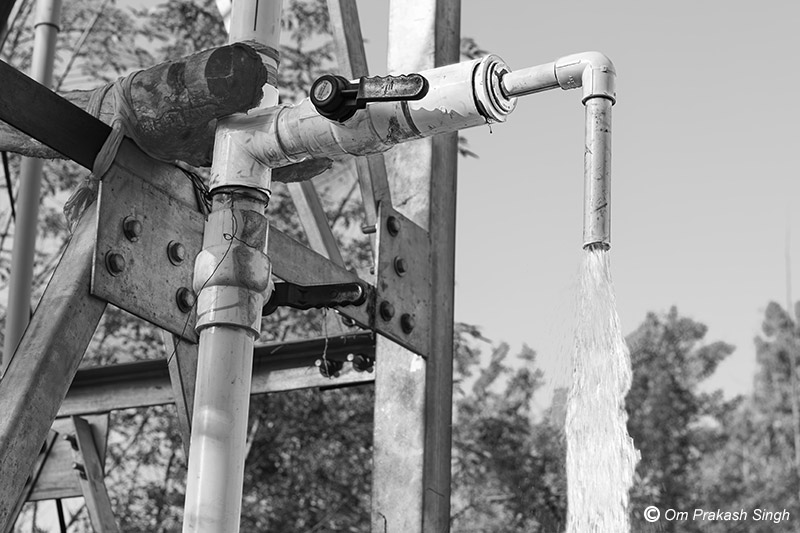
An innovative users’ solution for cleaning their SVS tank in Seraikela-Kharsawan district
Regular cleaning of the overhead tanks in the SVSs is essential for fulfilling the JJM goal of supplying safe water to every rural household. The cleaning process, besides maintaining water quality, also builds villagers’ trust in consuming the water. This photo shows an interesting local innovation that helps the users clean their tank by first washing it with the inflowing water and then allowing the wastewater to be drained out through a special outflow pipe that has been fixed into the rising main. The innovation was integrated into the SVS by the implementing contractor on the advice of the user group. This approach may be replicated in its present form, for facilitating regular cleaning of the overhead tanks in those SVSs that are already implemented. In forthcoming schemes, improvements may be added in the design to enhance efficiency.
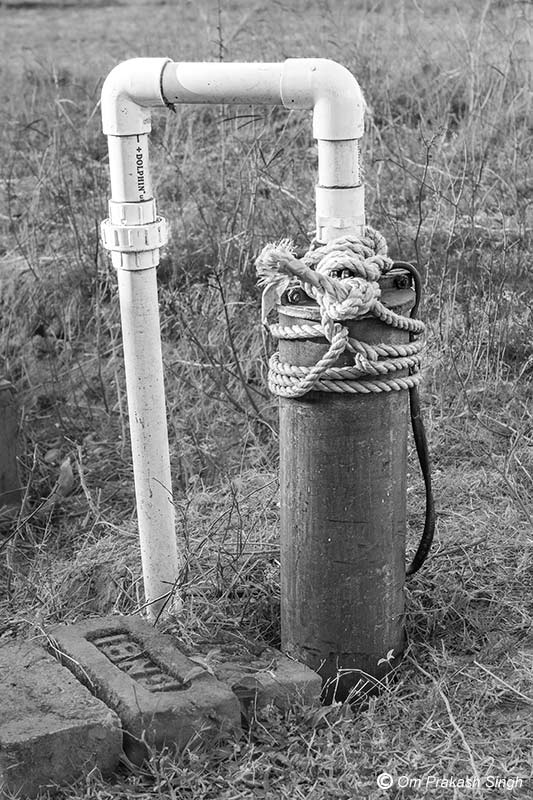
A tubewell that extracts groundwater for supply from a rural SVS in Seraikela-Kharsawan district
The SVSs are heavily dependent on groundwater, which is an increasingly depleting resource in Jharkhand. As a result, a good number of SVSs were found to have dried up after installation. Thus, ensuring source sustainability is a prime necessity for upholding the effectiveness of JJM as a rural water supply program that leaves no one behind. This requires a 2-pronged approach. First, reliable prediction of aquifer depth and yield to optimize tubewell placement and performance; and second, adoption of suitable actions to improve aquifer recharge and groundwater levels.
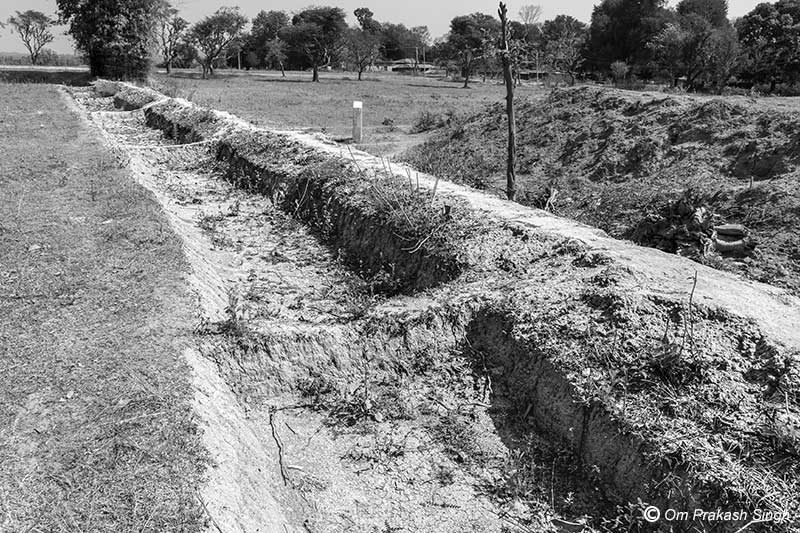
Water absorption trenches constructed under a government-sponsored watershed project in Khunti district
The national JJM guidelines underscore the importance of incorporating measures for source sustainability, such as rainwater harvesting and borewell recharge structures, to be implemented in coordination with other government programs. Watershed management structures, created as part of the watershed program of the government, offer great potential in this regard. A Water Absorption Trench (W.A.T.), as shown above, is a critical watershed structure comprising shallow pits dug along slopes to slow down surface runoff and facilitate groundwater recharge, while also enhancing water retention in surface water bodies. Given the above-stated scenario, where several groundwater-based SVSs are turning dry, there is an urgent need to ensure the convergence of JJM with watershed management programs in the state. The recent incorporation of this component in the newly drafted Operation and Maintenance Policy for JJM in Jharkhand is a commendable step; however, its effective implementation in the future will be crucial.
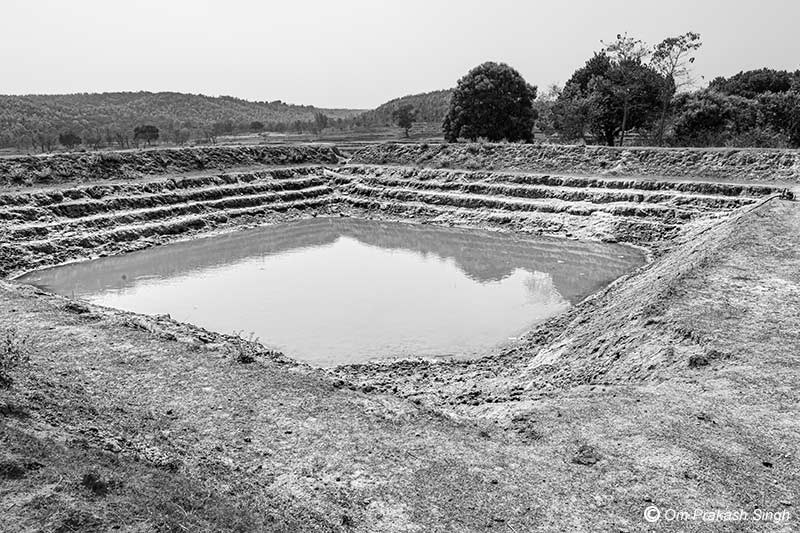
An irrigation pond created under a government-sponsored watershed project in Khunti district
The pond seen above is part of the watershed project discussed earlier, recharged by the upstream W.A.T. shown previously. It primarily supports irrigation and also helps recharge a downstream spring-based traditional drinking water source. Such examples highlight the potential of watershed management for both groundwater and surface water recharge. To strengthen source sustainability under JJM, thus, integrated watershed interventions should be promoted and replicated in suitable locations, where groundwater-dependent systems exist.
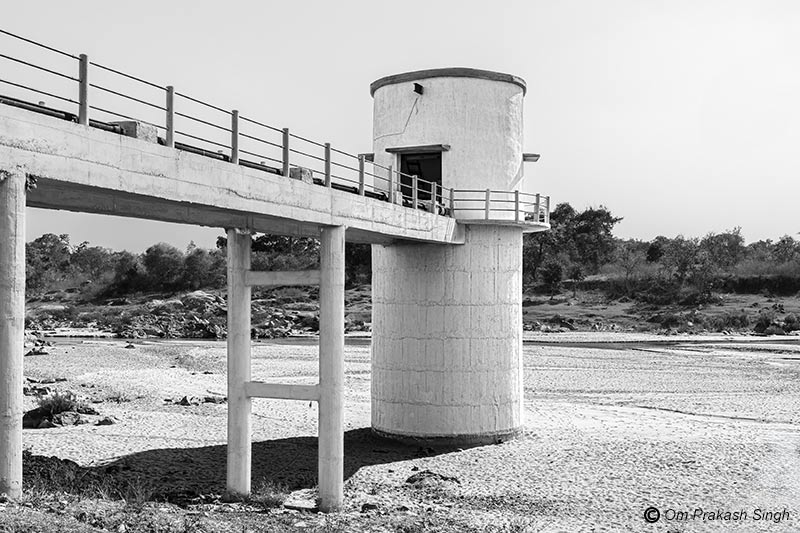
The Intake Well of an MVS located in a dry riverbed in Khunti district
Source sustainability is a growing concern for MVS too, which are mainly dependent on river systems in Jharkhand. The once-perennial rivers of the state are drying up due to erratic rainfall, deforestation, minerals and sand mining, and poor watershed management. With multiple JJM schemes drawing from the same river course, water availability is declining even more sharply, increasing the risk of dry taps during summer. While the recent government announcement restricting sand mining operations in rivers up to 200 meters around MVS intake wells is a welcome step in this direction, watershed interventions are further essential to restore catchments, enhance river flows, and secure water resources for MVSs.
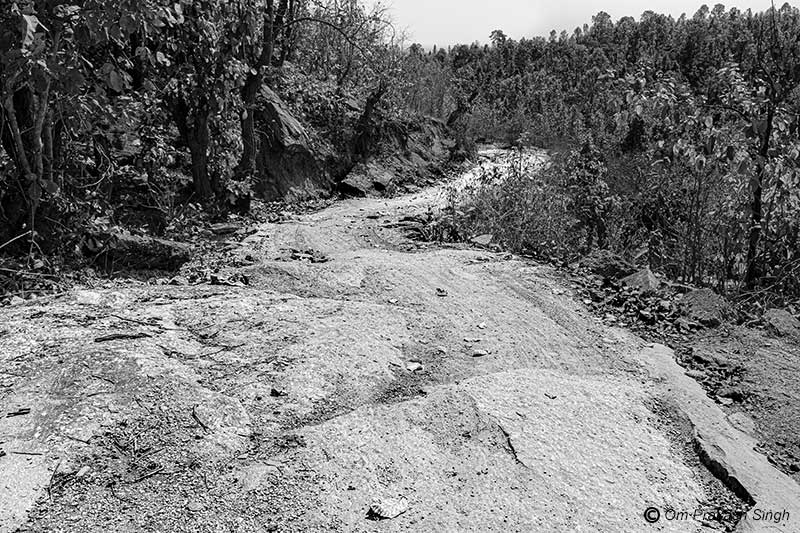
A narrow non-motorable path across a hilly terrain leading to a rural habitation in Gumla district
In Jharkhand, many tribal villages are remotely placed and face serious accessibility challenges due to hilly terrain, dense forests, and poor road infrastructure. This has been an important cause of delay in implementing JJM schemes in the state since the drilling equipment needs to be driven down a motorable road to the habitation for action. Also, maintenance teams have been unable to reach sites to repair non-functional systems. These delays highlight the need for improved infrastructure and planning in hard-to-reach zones. Closer collaboration with the road transport department is necessary in such situations, so that all such settlements can be prioritized in the construction of motorable road networks.
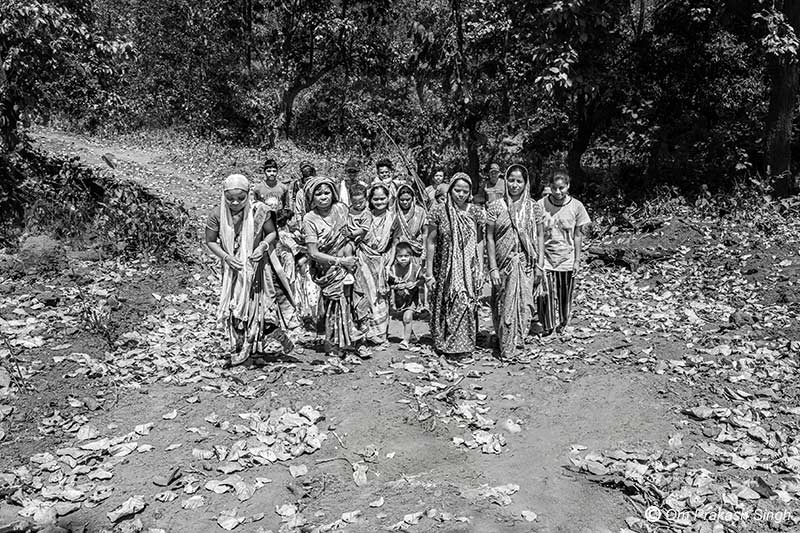
A PVTG community proudly walking along the unpaved road constructed by them to facilitate the driving of a truck-mounted drilling rig to their habitation in Gumla district
The community shown in the above photo belongs to a Particularly Vulnerable Tribal Group (PVTG) known as Korwa. The village lacks a JJM scheme due to absence of road connectivity, causing severe distress over drinking water access. Motivated by the hope of getting a borewell-based SVS, each household contributed with an amount of Rs. 1000 to make a total collection of Rs. 18000 and provided labor to build the unpaved forest road by themselves as seen above. They now await the arrival of truck-mounted drilling rig, hopeful that their water crisis will soon be resolved. The Drinking Water and Sanitation Department (DWSD) must respond promptly to such community-driven efforts. Furthermore, lessons from this compelling example of grassroots action should be documented and widely disseminated to strengthen community participation under JJM.
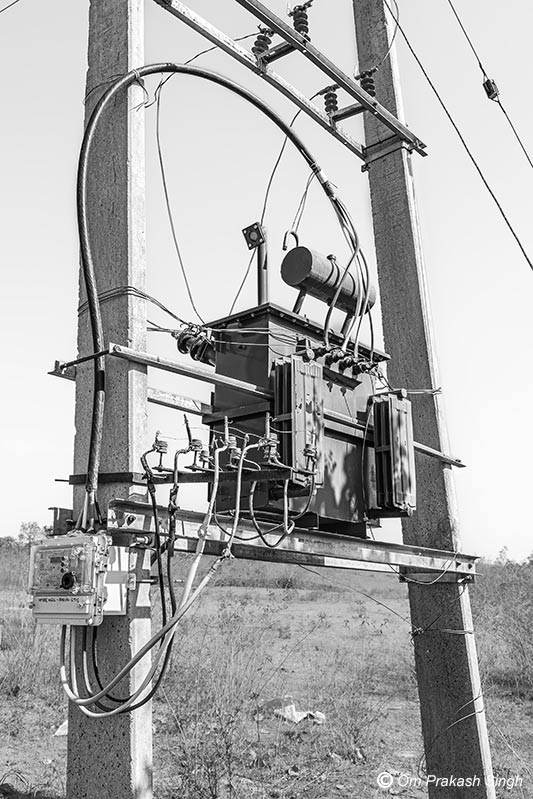
A power transformer feeding the Intake Well of an MVS in Gumla district
A vital aspect of JJM that requires improved inter-departmental coordination concerns power supply. MVS are heavily dependent upon electricity for a major part of their processes, from water abstraction through water treatment up to storage in the elevated service reservoirs (ESR) for village-level distribution. In several cases, the power supply is erratic, leading to inoperative MVS and resultant dry taps in the villages. There is an urgent need to step up coordination with the local power authorities and ensure regularity of supply.
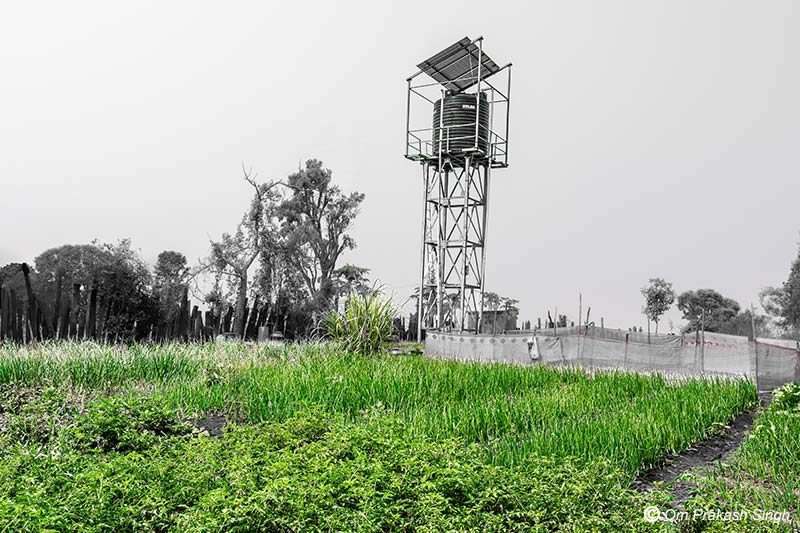
Precious and scarce groundwater from JJM scheme being used for raising crops in Latehar district
Groundwater is scarce in many areas of Jharkhand. For example, in parts of Latehar district it occurs mainly in weathered and fractured hard rock, making availability uneven and localized. Yet, as seen in the photo, precious groundwater from JJM taps is being used for irrigation, risking inequitable access to drinking water for the tail-end users of the pipeline, as well as questions of future source sustainability. To safeguard long-term drinking water security, JJM schemes should include ‘demand-side regulation’ through community awareness and water-use rules, ensuring that taps are prioritized for domestic needs while irrigation is supported by separate schemes like surface water harvesting or lift irrigation.
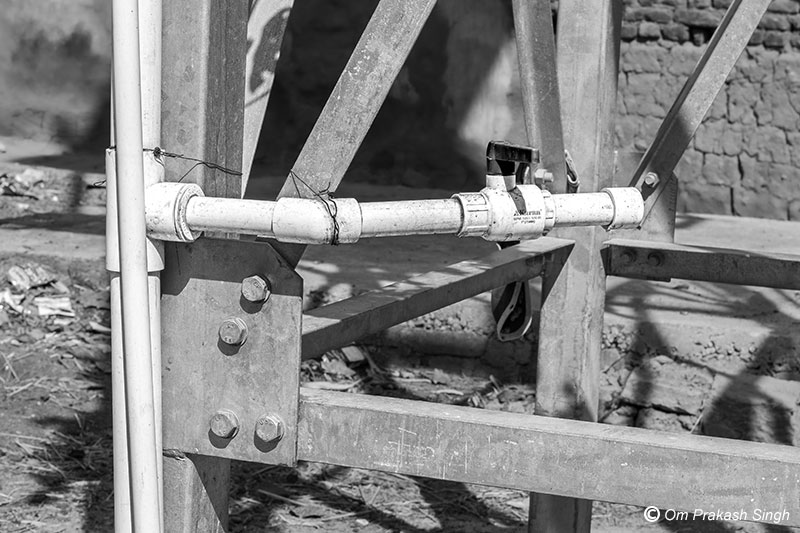
A ‘privatized’ outlet from the Rising Mains for direct withdrawal of JJM drinking water by the landowner in Gumla district
In some tribal-dominated villages where public land is unavailable, private plots have been donated for JJM scheme installations. However, this can lead to landowners attempting to ‘privatize’ the SVS. During the study visit, one such case was observed where a community asset was altered by adding an outlet to the rising main, allowing direct withdrawal of borewell water before it reached the overhead tank. This undermines equitable access, reduces reliability, and risks over-extraction from fragile aquifers, threatening long-term sustainability. Unauthorized changes also raise costs, damage infrastructure, and erode community trust—jeopardizing service delivery and program effectiveness. To prevent this, Village Water and Sanitation Committees (VWSCs) must be strengthened to monitor and regulate JJM infrastructure, ensuring assets remain community-owned and equitably accessed.

Storage of supplied JJM water at a rural home in Seraikela-Kharsawan district
The JJM water supply is generally time-bound, whether through SVS or MVS. This necessitates storage because it is often not feasible for the entire household to complete all their water-related chores during the brief supply period. However, many tribal and other marginalized households lack adequate facilities for water storage, because of which women and girls are forced to travel to distant water sources for procuring and using water. This dampens the very purpose of JJM in providing drinking water supply at home. One of the ways to address this practical challenge is to provide subsidized storage tanks to marginalized households, prioritizing women-headed families, through convergence with relevant rural development initiatives. These could be high quality durable plastic tanks or constructed RCC tanks.
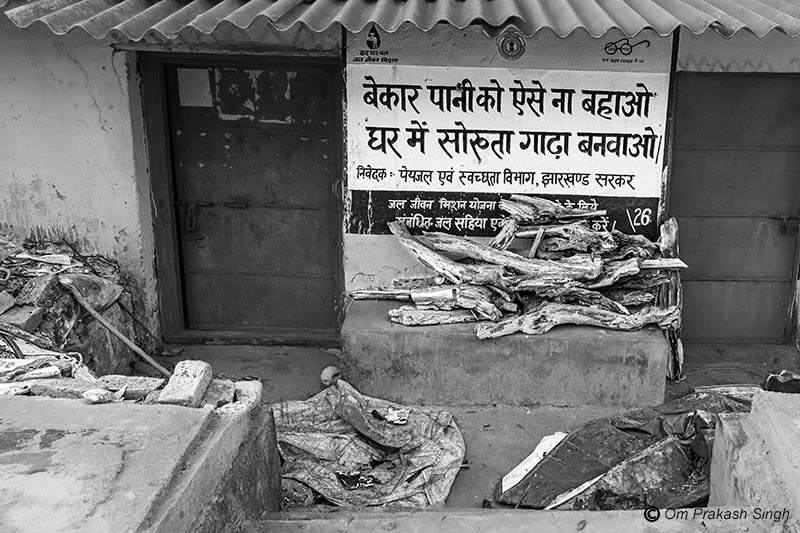
An inconspicuous IEC message written on a private wall in a village in Khunti district
Information, Education and Communication (IEC) components in Jharkhand’s JJM implementation have been weak. Very few IEC messages have been displayed so far, and even those few are not always located appropriately, thereby making them ineffective. The above photo shows an IEC message which has little impact, because it is located in a chaotic setting obscured by logs which thwart the visibility. For maximum effectiveness, IEC messages should be displayed at appropriate locations with clear visibility and accessibility to engage communities effectively in JJM’s water conservation and hygiene goals.

A broken rural community handpump in the JJM era in Khunti district
Before JJM brought piped water through household taps, community-based drinking water sources, most commonly handpumps and wells, were the rural water supply options. With the coming of JJM taps, these community-based sources confront the risk of falling into disrepair and negligence. However, given the unreliability of JJM schemes due to various reasons as discussed in this and previous articles, it is definitely wise to retain the older community-based drinking water sources in a healthy condition. In fact, the national JJM guidelines do prescribe this, but action must be coordinated to undertake repairs and regularly monitor the status of community-based water sources.

A damaged community well awaiting repair in Gumla district
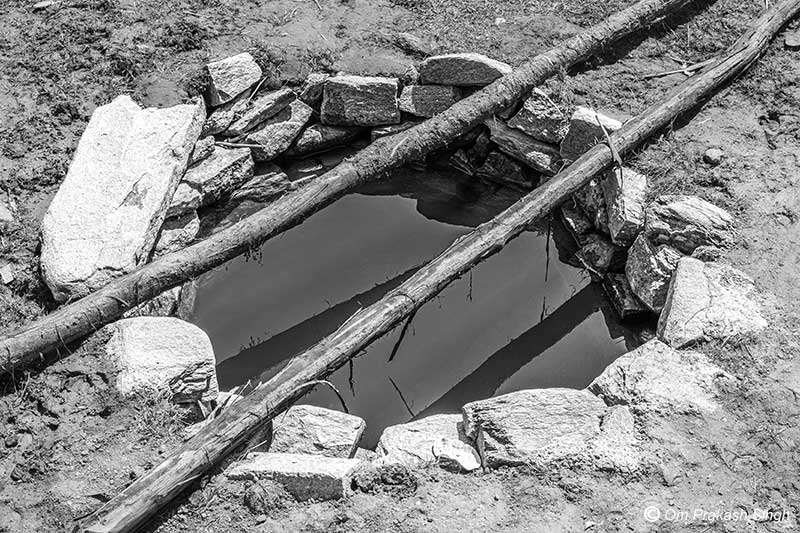
A stone-lined traditional spring-based water source in a PVTG village in Gumla district
In Jharkhand, rural women traditionally depend on reliable, high-quality spring-based water sources, and this practice continues despite the installation of JJM schemes in many villages. However, these are often distantly located amidst lowland paddy fields, which hinders accessibility. JJM guidelines endorse rejuvenating traditional sources to augment drinking water, but implementation lags. To enhance water access, especially on occasions of JJM failure, there is need to rejuvenate springs, ensure their regular maintenance for consistent water supply, and also construct paved pathways for safe, equitable access. This aligns with cultural preferences and JJM’s goal of sustainable water supply, reducing women’s travel burden.

An old traditional spring-based water source with decaying wooden lining in Khunti district
The old wooden-lined spring-based source seen in the photo is in a state of decay but continues to be intensively used. Two JJM schemes have been planned for the village, but their implementation is much delayed – already by nine months at the time of the study visit. There is a need to rejuvenate this source to enable safe drinking water access in the village.

Discontented Jal Sahiyas - key grassroots agents for JJM - in Gumla district
In the context of JJM in Jharkhand, Jal Sahiyas are women from local communities who are trained to support the community for equitable and reliable water access. They monitor water quality, promote hygiene, mobilize community participation, and ensure sustainable management of water resources. They are paid a monthly honorarium as a token of their efforts. However, the study visit revealed that Jal Sahiyas feel discontented and work with low levels of motivation. They feel that their responsibilities far outweigh the amount of the honorarium paid, despite the recent enhancement from Rs. 1000 to Rs. 2000 per month (announced in March 2024). Even greater discontent arises from the fact that the payment of even this small amount is often delayed for long periods of time. Though they started working for JJM in 2019, the first payment was received as late as 2022, and payment at the enhanced rate is yet to be received. The government should reconsider the working conditions of these key grassroot functionaries and secure regularity of payments, besides considering further enhancement of their honorarium, so that their motivation remains high.

Interactions with some members of a VWSC in Seraikela-Kharsawan district
VWSC is the most important link between the village community and the JJM implementation machinery of the state. The president of VWSC is the head of the Gram Panchayat (village level local government) while Vice-President is the elected Gram Panchayat member from the village (preferably woman). Nine residents of the village are the members, of whom 50% must be women. Jal Sahiya acts as the treasurer. Presently, the role of VWSCs is not clear and these are not well integrated in the implementation process. In the above photo, some VWSC members in a village are discussing their unresolved problems concerning JJM implementation with one of the authors. There is a need to empower VWSCs with the knowledge, skills, and responsibilities required to plan, implement, manage, operate, and maintain in-village JJM schemes. Equally important is the institutionalization of community-driven governance mechanisms, supported by the government through capacity building, technical assistance, and accountability frameworks, to ensure sustainable and inclusive water service delivery.
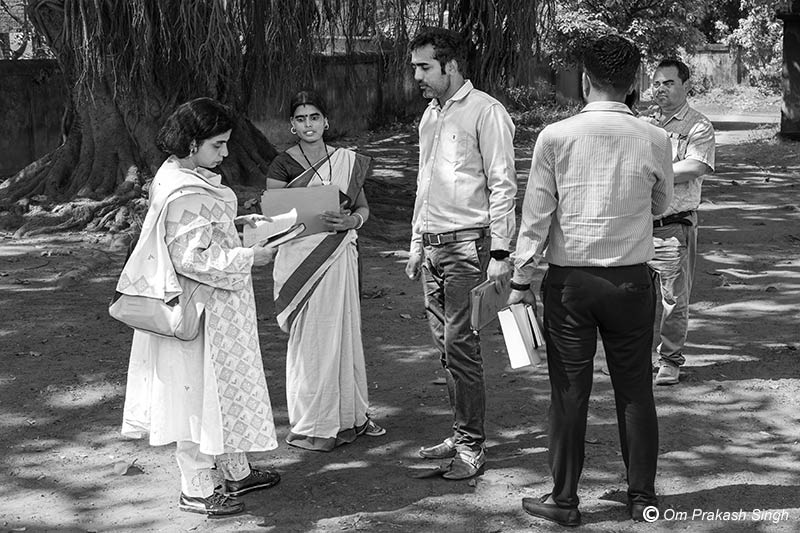
Government functionaries and Jal Sahiya briefing one of the authors about their challenges in implementing JJM in Seraikela-Kharsawan district
Frontline functionaries of the Drinking Water and Sanitation Department are responsible for implementing JJM in villages. Effective execution requires regular monitoring from installation to long-term maintenance. However, during the study visit, it was found that staff cannot make regular field visits due to lack of departmental vehicles. If they would choose to use personal vehicles as a solution, there exists no reimbursement of fuel expenses. This disconnects them from ground realities and limits their ability to supervise Jal Sahiya and construction agencies. To improve oversight, field vehicles or fuel support must be provided. Additionally, capacity building is essential to equip frontline workers with technical skills, problem-solving abilities, and community engagement strategies for sustaining the program’s impact.
JJM is not only a rural water supply program, but it also holds transformative potential for rural communities, especially women and girls, by ensuring access to safe, adequate, and regular drinking water supply at home. In Jharkhand, the program has made notable progress in expanding rural tap water coverage, but to transform the JJM potential into reality, there is need to move beyond mere coverage statistics. This requires efforts at enhancing its effectiveness by focusing on quality, reliability, and equity in the water service delivery processes. The latter, as evident from the findings of the field study, remains thwarted for many communities due to persistent gaps in infrastructure, source sustainability, community engagement, and institutional accountability.
The key to realizing the full potential of JJM and transforming it into a program that truly promotes gender equity, human rights and social justice, lies in applying a socio-technical systems lens while analyzing and addressing the gaps. This lens helps us see that sustainable and equitable water access through JJM is about designing systems where technology serves people and people shape technology. By viewing JJM as a socio-technical system, we can better identify the root causes of implementation gaps and design more holistic, sustainable, and inclusive solutions, guided by values of gender equity, human rights, and social justice. It implies that enhancing JJM effectiveness is not simply about installing taps or improving pipeline networks (technical components) but depends equally on how institutions manage the technical infrastructure, how communities engage with them, how information is communicated, and how equity and accountability are ensured (social components).
The recommendations proposed in this article must be seen as a comprehensive set of urgent actions in which technical components are closely integrated with social dimensions. Hardware problems—such as broken taps, leaking pipelines, uncovered and uncleanable overhead tanks, and inefficient solar panels—are not merely engineering flaws; they reflect deeper systemic disconnects between technology and its social context. From this perspective, solutions must integrate both technical design improvements and social processes. For example, improving infrastructure quality through better materials and construction standards, and integrating cleaning mechanisms into system design, are technical interventions that must be supported by social systems such as community monitoring, skilled local personnel, and responsive grievance redressal. Ensuring regular maintenance of solar panels and overhead tanks requires not only physical access and design foresight but also institutional accountability and active user engagement.
Similarly, improving source sustainability through convergence with watershed management and groundwater regulation exemplifies the ecological integration required in socio-technical systems, where natural resource management is coordinated with technological infrastructure and community participation. This is rooted in the integrated water resources management (IWRM) approach. Addressing access challenges in remote tribal areas through improved road connectivity is a technical enabler that must be informed by equity-focused planning and inter-departmental collaboration. Strengthening community institutions like VWSCs and Jal Sahiyas through training, fair compensation, and timely payments highlights the critical role of empowered social actors in maintaining and managing technical systems. Recommendations for demand-side regulation and protection against privatization of community assets underscore the importance of governance and collective ownership in safeguarding equitable access and long-term sustainability. Finally, effective Information, Education and Communication (IEC) strategies are essential for fostering behavioral change, building awareness, and ensuring that communities are active participants in the system.
In conclusion, improving the effectiveness of JJM requires embedding technical solutions within inclusive, accountable, and adaptive social structures. By implementing the integrated set of recommendations outlined in this article, JJM can transition from a numbers-driven program to a truly inclusive, sustainable, and community-led water supply initiative. This transformation will enable JJM align truly with Sustainable Development Goals (SDGs), particularly those related to clean water, gender equality, and climate resilience, and the Human Right to Water framework, ensuring that no one is left behind.